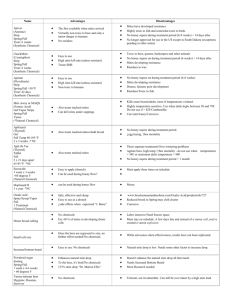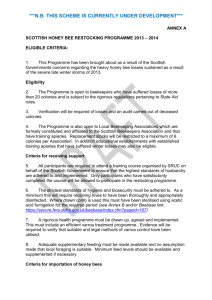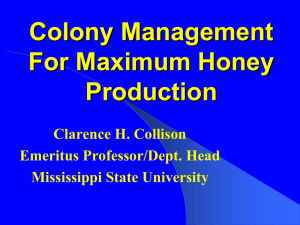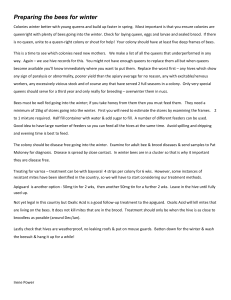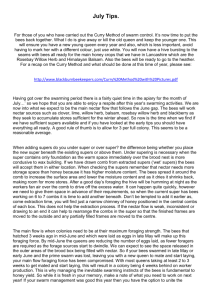Sept Oct 2010 - Ayr and District Beekeepers` Association
advertisement
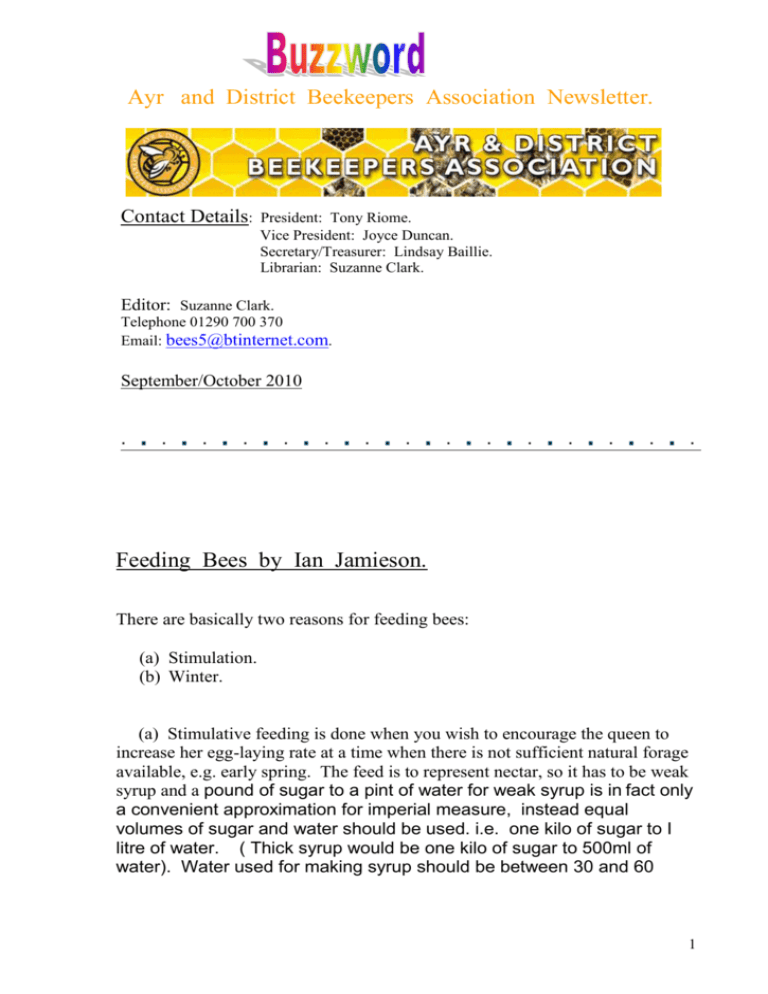
Ayr and District Beekeepers Association Newsletter. Contact Details: President: Tony Riome. Vice President: Joyce Duncan. Secretary/Treasurer: Lindsay Baillie. Librarian: Suzanne Clark. Editor: Suzanne Clark. Telephone 01290 700 370 Email: bees5@btinternet.com. September/October 2010 Feeding Bees by Ian Jamieson. There are basically two reasons for feeding bees: (a) Stimulation. (b) Winter. (a) Stimulative feeding is done when you wish to encourage the queen to increase her egg-laying rate at a time when there is not sufficient natural forage available, e.g. early spring. The feed is to represent nectar, so it has to be weak syrup and a pound of sugar to a pint of water for weak syrup is in fact only a convenient approximation for imperial measure, instead equal volumes of sugar and water should be used. i.e. one kilo of sugar to I litre of water. ( Thick syrup would be one kilo of sugar to 500ml of water). Water used for making syrup should be between 30 and 60 1 degrees Celsius. In the early Spring, you may wish to build up your colonies early if you are planning to take your hives to Oil Seed Rape which flowers too early for colonies building up naturally. Some beekeepers use early stimulation with a view to producing early queens, but this is generally unwise as shortage of mature drones and drones of different parentage, not to mention bad weather, can seriously affect the possibility of getting queens mated successfully. Another reason for stimulative feeding, is to encourage the queen to increase her egg production towards the end of July and August when she is often reducing her production. The reason for doing so is to have plenty of young bees in the hive as it goes into the winter. This can be used on nucleus hives which are being prepared for over-wintering, or for uniting onto full sized hives which require to be re-queened. If used on full-sized, honey producing colonies, then the honey supers would have to be removed first to avoid any possibility of the sugar going into the honey. Stimulative feeding is normally done using a contact feeder over the feedhole. (b) Winter feeding is done after the honey has been harvested. Feeding should normally be completed by the end of September. As this is for winter food, it should represent honey and is therefore thick syrup and consists of two pounds of sugar to one pint of water. Refer to above for metric equivalent. Contact feeders can be used but they are generally slow compared to Miller or Ashforth feeders and if the weather is getting colder and the bees require a lot of stores, then the faster they can take it down the better. My own personal view is that winter feeding of established colonies should only be necessary in poor years when the colonies have been unable to store sufficient honey due to bad weather or for some other reason like prolonged queenlessness. I believe that part of the problem derives from the idea, which seems to have been handed down over the years, that the best beekeepers are those who get most honey from their hives. Perhaps this was in the mind of the inventor of the National Hive when he designed a brood box which a normal British Black queen could fill with brood. Consequently, all the honey would be stored in the super which could be removed at the end of the season. The bees would be left with a little honey in the brood box as the bees hatched out and incoming nectar at the end of the 2 season was stored in the vacated cells. The beekeeper would then feed sugar syrup to fill up the brood box. Beekeepers should be looking after their bees – not exploiting them. The bees have worked themselves to death over the summer to provide their successors with enough food to see them through the winter. The young bees reared in the late summer should be building up their fat-bodies for their survival during the winter and eventual raising of young brood in the spring. Processing and dehydrating sugar syrup is wearing out the very bees the colony is depending on for its survival. Using Ambrosia instead of sugar syrup is advocated as a better solution as it is an invert syrup and saves the bees from having to break down a disaccharide (white sugar) into monosaccharides. This is perhaps true, but the bees still have to evaporate the excess water which involves a lot of work, especially if the weather is wet. I have my reservations regarding Ambrosia. I like to know what I am giving my bees and there is no information on the container to tell you how the Ambrosia is made or what it is made from. There are reports that corn syrup, which has been widely used in America due to its cheapness, is injurious to bees. I have been unable to get clarification regarding the content of Ambrosia – the expert opinion I have been given is that sucrose i.e. white sugar is the best food for bees. There has been some suggestion over the years that cane sugar is better for bees than beet sugar but there apparently is no difference between beet and cane sugar when it is refined. When unrefined or semi-refined, it contains elements which are toxic to bees. Personally I always use Tate and Lyle cane sugar when I need to supplement their food supply. The winter requirement of a hive is around forty-five pounds of stores. I work on the principle that if the hive produces, say, eighty pounds of honey, then it can spare thirty for me and I leave it fifty, so there is no need to feed it. Honey is the best food for bees, and they will build up much better in the Spring. Organising an Apiary Meeting. This leaflet is provided as guidance for beekeepers who have the responsibility of organising or managing apiary meetings. It highlights some of the do’s and don’ts of apiary meetings. It is not however a definitive list of all the issues and does not absolve the individual 3 beekeeper from exercising all sensible precautions. Who is in charge of the meeting? This is the first issue that needs to be addressed: there can only ever be one person in charge. It may be the apiary manager if the apiary is an Association apiary, or it may be an official of the association, the apiary owner or an invited guest. Whoever it is, there must be only one person. What is the purpose of the meeting? Meetings are sometimes held without any defined purpose - often they are a convenient event for beekeepers to meet together on a nice summer afternoon. But as with all aspects of beekeeping, a little thought in advance will be of benefit. The prime objective may be to assess the strength or health of colonies, to demonstrate a particular technique or item of equipment, to host a visit from your Regional Bee Inspector or to hold a beginners’ meeting. Whatever the purpose, advance preparation will help. Some of the questions which could be asked beforehand include: Will they all be experienced beekeepers? Will there be any beginners or members of the public attending? How many people are expected to attend? Will everyone have protective clothing? What are the forecast weather conditions? Is there adequate parking and access generally? Has permission been sought from the landowner? What is the temperament of the bees at the site? Is there a nectar flow on? Preparation Plan and organise the meeting carefully. Determine who will run the meeting – one person only. List all essential equipment and who will provide it. Inform attendees what protective clothing is needed and arrange for them to borrow some if necessary. Make sure the landowner knows your plans. Make sure any neighbours who could be affected are aware of the meeting. Have a mobile phone to hand and know the exact location of the apiary and the nearest public phone. Identify whether any of the attendees have a known allergy to bee venom. At the meeting If any of the circumstances are not right, cancel the meeting. Make sure that people do not stand in the flight path of the bees. Watch that the apiary is not over-congested. 4 Do not attempt to administer any medical treatment unless you are qualified to do so. Put all brace comb, etc, in a container and remove it from the site.BriBritish Beekeepers’ Association Advisory Leaflet Number B6 © BBKA 2006 (3rd edition) The British Beekeepers’ Association, Stoneleigh Park, Stoneleigh, Warwickshire CV8 2LG You Know you’re a Beekeeper when….. You check out all the honey labels and prices at the supermarket. You've gone through the supermarket checkout line buying nothing more than a big load of sugar. The windshield of your vehicle has at least two yellow dots on it. There is propolis on the steering wheel of your vehicle and the bottom of your boots. You Know you’re married to a Beekeeper when… You spend at least one day a week on your hands and knees with a sharp knife scraping wax and propolis off your kitchen floor. You plan weddings, childbirth, surgery and funerals around honey extracting time. Frequently asked Questions. Beginners often ask: How does Varroa develop inside the hive and how can I check if my hives are infested? 5 Life Cycle of the Varroa Mite (Varroa Destructor) in the European Honey Bee Apis Mellifera 1) Varroa feed on the haemolymph (blood) of the bees by making punctures through the body wall with their sharp mouthparts. Mites have a preference for nurse bees. During the summer mites live for 2 – 3 months and readily transfer from bee to bee and brood cell to brood cell. In winter mites live much longer and over winter on adult bees within the cluster until re-entering the brood the following spring. Feeding of the mites can weaken and damage bees and brood. 2) To breed, an adult female mite enters a brood cell just prior to capping, where she remains in the brood food under the larva until the cell is sealed. Mites prefer drone brood but will also breed in worker brood. 3) Four hours after capping the female mite begins to feed off the developing bee, and establishes a feeding site for her offspring. 60-70 hours after capping the female lays the first of her eggs. 4) Each female mite lays 5-6 eggs, the first always being a male egg followed by 4-5 female eggs laid at regular 30 hour intervals. The male hatches first followed by the females. The male mite then mates with the female offspring within the cell. 5) Development of the mite (from a larval stage formed within the egg) is through two principal juvenile stages: the protonymph and the deutonymph before becoming an adult. Time from egg to adult for males is 5-6 days and for females 7-8 days. 6) The duration of each reproductive cycle is limited by the development time of the bee, so more mites are produced in drone brood than in worker brood. Not all females reach maturity and mate by the time the bee emerges from the cell. Mature female mites leave the cell with the emerging bee. Immature females and the males do not survive outside the cell. Severe damage is caused by the mites’ feeding activities. Monitoring Varroa When you find varroa for the first time, you must learn to regularly estimate the level of infestation throughout each season. Infestation will build up more quickly in some years than in others and more quickly in some apiaries than others. A control programme that was effective one year will not always be effective in another. 6 Monitoring your colonies routinely can tell you how mite infestation is developing. You can then use this information to decide what and when control methods will be appropriate. How often should I monitor? Ideally, you should aim to monitor at least four times each season: early spring, after the spring honey flow, at the time of honey harvest, and late autumn. If you think significant mite invasion is taking place then the frequency with which you monitor should be increased. . Two commonly used varroa monitoring methods. Monitoring natural mite mortality. (Mite Drop) 1. Maintain the colony on a varroa-floor with a sampling drawer/tray underneath . 2. Remember to remove debris from the drawer/tray regularly during the summer to prevent severe wax moth infestation. 3. At intervals examine the floor debris and count the number of varroa mites. Convert this to a daily “mite drop” figure by dividing by the number of days since the last measurement. 4. If there is a lot of debris (e.g. after winter) mites will be very difficult to find. Mix the debris with methylated spirit in a large container. Most mites will float to the surface whereas wax and propolis particles will sink. 5. Research work in the UK and overseas has shown a natural mite drop in a colony is related to the size of the varroa population. 6. UK research suggests that colony collapse is very likely before the end of the season if average daily mite drop for a normal colony exceeds the following: winter/spring=0.5mites; May=6mites; June=10mites; July=16mites; August=33mites;September=20mites. 7 Pros and Cons. Sensitive method capable of detecting very few mites. Can give a good idea of infestation level. Colony is not disturbed Needs additional equipment Monitoring takes several days Encourages wax moth if debris accumulates. Drone Brood Uncapping Method. 1. Select an area of sealed drone brood at an advanced stage (pink-eyed) as this is least likely to disintegrate when removed 2. Slide the prongs of a honey uncapping-fork under the domed cappings, parallel to the comb surface, and lift out the drone pupae in a single scoping motion. 3. Varroa mites are easily seen against the pale drone bodies. Repeat until at least 100 cells have been examined. 4. Estimate the proportion of pupae that have varroa mites on them. 5. Very roughly, if more than 5-10% of drone pupae are infested, then the infestation is serious and the colony collapse may occur before the end of the season. Pros and Cons. Quick and easy to use. Can be used during routine colony inspections Gives instant indication of infestation level. Unlikely to detect a very light infestation. 8 Results are approximate. The Aim of Varroa Control The fundamental aim of varroa control is to keep the mite population below the level where harm is likely, (known as the economic injury level), therefore maintaining healthy colonies of bees for the production of honey and other hive products, and for pollination. It is not necessary to kill every single mite for effective control and it is not usually desirable to attempt this. However, the more mites that are left behind, the quicker they will build up to harmful levels again. With 80% efficacy the danger level (of 1,000 mites) is reached again in only 65 days, with 90% in 100 days and with 99% population growth is slow so that assessments can be made the following season. When Should You Treat There is no single ideal time for treatment with varroacides. However, for most beekeepers the main treatment time is late summer to early autumn – between harvest in honey and preparing colonies for winter. At this time colony size will be reducing while infestation will be continuing to increase. The aim of treatment is to significantly reduce the mite population to protect the last few brood cycles that produce the young bees needed for successful colony survival over winter. It is also relatively common to treat colonies in the spring- especially where monitoring suggests that they have emerged from winter with a mite population that will pose a serious risk before the late summer treatment. The choice of treatment may dictate when treatment is applied. Some (e.g. Apiguard) may require warm conditions for maximum efficacy. Others (oxalic and lactic acid) require broodless periods to be effective and so are usually applied very late in the year. Generally beekeepers prefer to avoid treating during the active season when supers are on the hive to minimise the risk of leaving residues in bee products. However, some proprietary treatments (e.g. Apistan and Bayvarol) can be used quite safely during a honey flow if necessary (although not during comb honey production). This is useful if unexpected serious infestation demands emergency treatment. Extracted from a publication by DEFRA. 9 Why are Colonies United? Reasons for Uniting. The United colony will have a better chance of survival than the component parts. To combine small colonies into one colony (queen-rearing nuclei) To unite a queen-right colony to one that is queenless To sort out a colony with laying workers (not a drone –laying queen) To add a swarm to a full colony. To combine several swarms together. To reduce the number of colonies taken into winter. To create a strong foraging force for a particular flow. To combine mating nuclei at end of season. Uniting Methods. Direct: Simply move the two units together so that the hives are close together and the foragers appear to be orientating to one place. On a good flying day move both colonies to one side. Assuming both colonies are queen-right, find both queens. Destroy the one you do not want and cage the other on a frame of her own bees. Place a new brood box on the original site, place frames of brood and bees from the two colonies into the empty brood box one at a time, alternating the frames, that is, except for the frame with the queen cage. The queen must be placed between two frames of her own bees. The frames can be dusted with flour or sprayed with scented water. Paper Marriage: This can be regarded s one of the safest methods. It will work at any time in the active season even when robbing is prevalent or at the end of a flow. Put briefly, the beekeeper goes to one of the colonies at dusk, removes the inner cover and places a single sheet of newspaper over the top bars. A few holes a pricked in the paper with a 2.5cm nail (small enough to prevent bees pushing their way through). Pick up the brood box of the second colony and place on top of the paper. Carefully line up the boxes. The bees will chew through the paper and combine. Scraps of shredded paper on the alighting board will indicate that the bees have united. Leave alone for at least a week, then rearrange the combs of brood. Uniting is more likely to succeed: During a flow (you can create an artificial flow be feeding). If three or more lots of bees are united at one time. If the queen is given special protection. If something is used to disguise the individuals’ scent. If the bees are confused (dust with flour, talcum powder or scented sugar water). At the end of the year. Practical Beekeeping. Clive de Bruyn. 10 Visiting Lecturer Dinah Sweet will be speaking on Simple Queen Rearing Methods at Belmont Academy on 27th September at 7.30pm. There will be a charge of £1.50p for tea. Flower Show. Once again many thanks to all our brilliant volunteers who helped to make our contribution such a success. It has to be said again, please can we have more people volunteering: it is always the same people who turn up to help. This will be addressed more fully at the AGM. Congratulations to those who were successful in their chosen category . Christine Matthews received most points for her displays. Well done Christine and we hope to see you back next year. In view of the need to plan well ahead for the Flower Show, and the fact that the association plans to enter the Golden Rose competition, the committee feels it would be helpful to form a small sub-committee to plan for next year’s event. Those volunteering and those suggested as possible volunteers include: Helen Hepburn, Jane Sik, Joyce Duncan, Margaret Foster, Phil McAnespie and Vicki Stirling to be asked to help with plants. Those people wishing to sell their honey at the Flower Show will be asked to donate 1lb. of honey to the honey tasting stall. August 12th 1910. High drama hit the area this week when a swarm of bees attacked a horse. The bees, restless after their honey had been taken from their hive the day before, attacked the horse when a carter from Laight Farm, New Cumnock, was emptying an ashpit. 11 A number of nearby workers came to rescue the despairing filly and were also stung. The horse was eventually led to safety suffering from a swollen head and neck. Cumnock Chronicle ll.8.2010. Association Library. Many Thanks to those who have returned books since the last Buzzword. There are still some outstanding. It would be appreciated if they could be returned soon. We are rapidly approaching the time of year when reading about beekeeping, rather than actually doing beekeeping is to be recommended, especially for beginners. A couple of books which are easily accessible as a practical guide to beekeeping are: The Complete Guide to Beekeeping by Jeremy Evans in collaboration with Sheila Berrett. This book gives a seasonal account on how to keep bees, explained in terms a beginner will find easy to understand but is nonetheless thorough and a relaxing read. Bees at the bottom of the Garden by Alan Campion. Has a separate section dealing with swarming and uniting, also the beekeeper’s year in calendar form. Both these books are readily available. Contact Northern Bee Books, Scout Bottom Farm, Mytholmroyd, Hebden Bridge, West Yorkshire. HX7 5JS suppliers of new and out of print bee books, or go online for BBKA publications or sign up to Beecraft magazine to be kept up to date with the latest news. This is the official journal of the British Beekeepers Association. Email: secretary@bee-craft.com. If anyone knows of a book dealing with beekeeping they would like to see in the Association Library, please let me know. 12 x. unlikely to detect a very light infestation. x. results are approximate 13 14 ciation Advisory Leaflet Number B6 15
